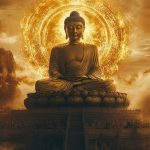The River’s Embrace: Moksha and the Buddha’s Path to Inner Freedom
The river moves, sometimes gently, sometimes with a powerful rush, always heading towards the vast, open sea. It doesn’t fight its banks or hold onto the stones along its bed. This steady, effortless journey of water offers a beautiful metaphor for a different kind of freedom.
It’s not the freedom we often pursue in our busy lives – through possessions, status, or quick escapes – but a deeper, more fundamental release. This is the heart of Moksha, a liberation illuminated by the Buddha’s teachings, offering a tangible path to inner freedom that each of us can explore.
The Whispering Current: Understanding Moksha’s Essence
Moksha, often understood as liberation or release, speaks to a deep, inherent longing within us. It’s not about leaving the world behind, but about freeing our minds from the ties that create suffering.
Imagine a leaf caught in a small, swirling eddy, trapped in an endless circle. Moksha is the gentle act of letting go, allowing that leaf to rejoin the main current and move freely onward. This represents a significant shift: from constantly striving externally to finding peace within. It’s a quiet understanding that helps us move through life’s challenges with grace.
We often measure freedom today by what we gain or achieve. However, as Moksha teaches, genuine freedom comes from what we can release. It’s a freedom from attachment, from craving, and from the illusion of a separate self that is always seeking and fearing. This inner liberation provides a lasting peace, quite distinct from the fleeting joys the world typically offers.
The Eddies of Existence: Understanding Samsara and the Roots of Our Unrest
To truly talk about liberation, we first need to understand what holds us captive. The Buddha described Samsara as the continuous cycle of birth, death, and rebirth, fueled by craving and ignorance. Think of it like the endless waves on a shore: each one appears, rises, then fades back into the ocean, only to be followed by another.
This cycle isn’t just about physical reincarnation; it’s a profound description of our experience, moment by moment. Our minds often get caught in eddies of desire, aversion, and delusion, which inevitably lead to suffering. We cling to pleasant moments, push away uncomfortable ones, and often miss the impermanent nature of everything. This constant cycle of clinging and aversion is, in fact, the deep root of our unrest.
Following the Current: The Buddha’s Noble Eightfold Path to Liberation
Once the Buddha understood the nature of suffering and where it comes from, he offered a practical guide to step out of Samsara: the Noble Eightfold Path. This isn’t a strict set of rules, but rather a gentle current that steers us toward liberation. It’s much like a river gracefully carving its way through the land, always finding the most natural path to the sea.
This path is thoughtfully organized into three core areas: wisdom, ethical conduct, and mental development.
Cultivating Stillness: The Practice of Meditation
Central to mental development is the practice of Meditation. Picture finding a calm pool beside a river, where the water is perfectly still and clear, reflecting the sky without any distortion. Through meditation, we learn to cultivate a similar stillness within our own minds.
It’s a practice of simply observing our thoughts and emotions without judgment, letting them appear and then fade away, much like clouds drifting across the sky. This inner stillness slowly weakens the hold of craving and aversion, gently revealing the true nature of reality.
Right Understanding and Action: Wisdom in Daily Flow
The path also highlights wisdom, starting with Right Understanding (of the Four Noble Truths) and Right Thought (focused on non-violence and compassion). These insights then shape our ethical conduct, which includes Right Speech, Right Action, and Right Livelihood.
Just as a river flows in harmony with its surroundings, creating a path that nourishes life, our wisdom-guided actions build a life that reduces harm and supports well-being for everyone. This mindful approach helps us move closer to spiritual freedom in every single moment.
The Open Sea: The Horizon of Nirvana and Spiritual Freedom
So, what truly awaits us at the journey’s end? The ultimate destination is Nirvana. This isn’t a heavenly place, but rather a state of deep peace and complete freedom from suffering.
Imagine the river finally flowing into the boundless ocean. The individual water drops are no longer limited by banks or currents; they simply become part of that vast, open expanse. Nirvana is the complete stopping of craving, aversion, and delusion, leading to ultimate spiritual freedom. This profound freedom is marked by equanimity, wisdom, and limitless compassion. It’s a state where the mind remains steady, completely undisturbed by the constant changes and conditions of the world. Think of the quiet strength of a mountain, standing firm through every season, observing all changes without ever being shaken.

Echoes in the Valley: Moksha in Our Modern World
The ancient wisdom of Moksha still speaks powerfully to us, even in our fast-paced modern lives. While most of us aren’t aiming to become monastics, the core principles of letting go, understanding suffering, and nurturing inner peace are truly universal. We can bring mindfulness into our daily routines – noticing the rustle of leaves, the rhythm of our breath, finding those small pockets of stillness amidst our busy schedules.
So, to circle back to our opening thought: perhaps true freedom isn’t about escaping the world, but rather learning to flow with it. Just like the river embraces every turn and obstacle, always knowing its ultimate destination. This journey toward liberation isn’t about dramatic changes; it’s built on consistent, small choices to observe, to understand, and to gently release. It’s about discovering that quiet strength within, letting the current of wisdom gently guide us towards our own expansive, open sea. To continue exploring this path and deepen your own inner stillness, consider integrating mindfulness and compassion into your everyday life.
💡 Pertanyaan yang Sering Diajukan
Moksha, often understood as liberation or release, is a deep, inherent longing for freedom from the ties that create suffering. It's not about escaping the world, but about freeing our minds from attachments, cravings, and the illusion of a separate self. This provides a lasting inner peace, distinct from fleeting worldly joys.
Samsara describes the continuous cycle of birth, death, and rebirth, fueled by craving and ignorance. Our minds get caught in eddies of desire, aversion, and delusion, leading to suffering. This constant cycle of clinging to pleasant moments and pushing away uncomfortable ones, while missing the impermanent nature of everything, is the deep root of our unrest.
The Noble Eightfold Path is a practical guide offered by the Buddha to step out of Samsara. It's organized into wisdom (Right Understanding, Right Thought), ethical conduct (Right Speech, Right Action, Right Livelihood), and mental development (Meditation). This path gently steers us toward liberation by cultivating stillness, wisdom, and mindful actions.
Meditation is a practice of observing thoughts and emotions without judgment, allowing them to appear and fade away. This cultivates a stillness within the mind, similar to a calm pool reflecting the sky. This inner stillness slowly weakens the hold of craving and aversion, revealing the true nature of reality.
Nirvana is the ultimate destination, representing a state of deep peace and complete freedom from suffering. It's the complete stopping of craving, aversion, and delusion, leading to ultimate spiritual freedom. It is characterized by equanimity, wisdom, and limitless compassion, where the mind remains steady and undisturbed by worldly changes.








